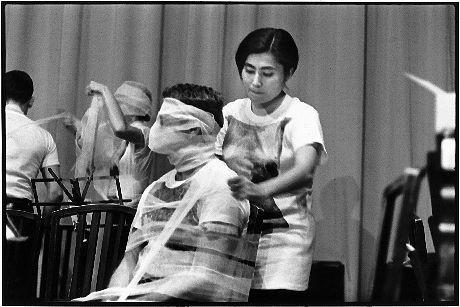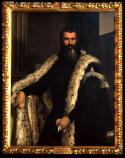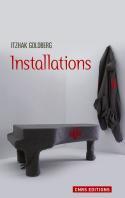Art Of The Day Weekly
#338 - from 20 March 2014 to 26 March 2014

Yoko Ono, Sky Piece to Jesus Christ, 1965 Performed piece for orchestra. Performed by Yoko Ono, La Monte Young (conductor), and the Fluxus Symphony Orchestra, Carnegie Recital Hall, New York, September 25, 1965. Photo by Peter Moore © Barbara Moore/Licensed by VAGA, NY.
IN THE AIR
Yoko Ono, Mrs. Lennon and so much more
BILBAO – She is known world-wide for having been John Lennon’s wife. But this fame can be double-binding for her own artistic activity: many believe Yoko Ono is no more than a dilettante of performance. Actually, having been born in Japan in 1933, and settled in the USA since 1952, she led a very active and intense artistic life over ten years, between happenings and exhibits in galleries, before meeting John Lennon. One of her works was actually the reason. John Lennon was very touched by Ceiling Painting, which he saw in 1966 at the Indica gallery in London, and he asked to meet the artist. The Guggenheim chose some 200 works among the corpus of this conceptual artist, poet, movie director, musician, whose creations can be disturbing such as the video Fly in which a fly explores a woman’s naked body. Some of the works are constantly renewed, like Air Dispensers or Water Event, created in 1971 and presented in an ‘updated’ version. Following Andy Warhol and Jack Nicholson, Olafur Eliasson, Pilar Albarracín and Christian Marclay in turn brought the containers which Yoko Ono ‘sculpted’ by filling them up with water.
• Yoko Ono, Half a Wing Show at Guggenheim Bilbao, from 14 March to 1 September 2014.
EXHIBITIONS
Art in time of war
LEUVEN – The second title tells it all: ‘Art and culture in times of conflict’. We remember the drawings done by Grosz and Dix during World War I, or the opera that was staged in the concentration camp of Teresin. As well as Michael Sweerts, who in the XVIIth century painted the god Mars crushing a sculpture, or Mona Hatoum who summarises in the figure of the bunkers the constantly renewed attack against art. Here we have a wide panorama of this activity armies so love. The city that hosts this retrospective was not chosen by chance: in August 1914, the fire set by German troops, that destroyed the library of Leuein caused an international uproar. But a full century of looting followed just the same. Will man ever change? In any case artists are careful watchmen and next to Turner or Pietro da Cortona, the exhibition opens a door to our contemporaries such as Sven Augustijnen (who looks into the history of Belgian Congo) or Fernando Bryce (who talks about the case of Leuven).
• Ravage at the M -Museum Leuven, from 20 March to 1 September 2014

Paolo Veronese (1528-1588), Portrait of a Gentleman, about 1555. Oil on canvas, 104.5 × 108 cm. Galleria Palatina, Palazzo Pitti, Florence (216) © Soprintendenza Speciale per il Polo Museale Fiorentino
Veronese the magnificent
LONDON - The National Gallery began with a unique asset when it worked on the project of a retrospective of Veronese, since it owns ten paintings by the Venetian master, among them The Family of Darius before Alexander or Adoration of the Magi). But they had to group together the remaining 40 works of art, and we know how museums hesitate to lend their works. While it was unconceivable to move Wedding at Cana from the Louvre, the frescoes of the palace of the Doges or from the church of the Frari, but what is brought together in London is nevertheless a first class choice … We will admire works by Paolo Caliari (1528-1588) –his real name, the great rival of Tintoretto- such as the Mystical Marriage of Saint Catherine (Accademia, Venice), the Bella Nani from the Louvre and two portraits of men, from Palazzo Pitti and the Getty Center. The works of so famous an artist have been scattered all over the globe and re-encounters can be surprising. One for example, is the one between two panels of an altarpiece from the little town of San Benedetto Po, separated since the 18th century that will once again live side by side, for a short period…
• Veronese, Magnificence in Renaissance Venice at the National Gallery, from 19 March to 15 June 2014.
San Gennaro, the soul of Naples
PARIS – If his blood did not turn liquid it meant a catastrophe was sure to occur … For over five centuries and ever since the original contract, the blood of this martyr from the time of Diocletian serves as a barometer for the city of Naples. The donations and works of art which his devotion has generated are coming out exceptionally from his chapel in the cathedral, and will be leaving the Posillipo for the Seine. The famous blood vials will not be coming of course, and the next liquefaction is foreseen for Saturday 3 May. But one has to go there to witness it…
• Le Trésor de Naples, les joyaux de San Gennaro at the musée Maillol, from 19 March to 20 July 2014.
Augustus, the center of the world
PARIS – The frail Octavius became the most powerful man on earth following the death of his step-father Cesar. He confirmed Rome’s power and played an important role in the colonisation of Gaul. This version of an exhibition already shown at the Coliseum in Rome brings together statues, bas-reliefs, Gallo-Roman tombs and living areas that have been reconstituted.
• Moi Auguste, empereur de Rome at the Grand Palais, from 19 March to 13 July 2014.
AUCTIONS
What Kikoïne liked
What could this man collect? He who was a painter of the Ecole de Paris, a Russian Jew carried by the winds of history, a colleague of Soutine’s at the school of commerce in Minsk, then a friend of Krémègne and Chagall at the Ruche in Paris? That is what we will see during the auction of the inheritance of Michel Kikoïne (1892-1968). He never met the fame of his companions, but the artist illustrates perfectly this cosmopolitan and frail world between the two wars, during which links were ever so much stronger since they were threatened by wars and exile. Fernand Léger, Roger Bissière, Fernando Bores, Alfred Manessier were some of these friendships that he materialised with the oils and drawings on the walls of his house, and which now pop up as so many memories. The most sought after lot is gouache by Léger (lot 53, estimate €30 000). Will Kikoïne’s mediocre rating undergo a little upheaval? His watercolours and gouaches are evaluated at a few hundred Euros and only his beautiful Femme aux tulipes jaunes (Woman with yellow tulips) from 1913 could go for more than €10 000.
• Succession Maratier-Kikoïne at Drouot-Richelieu, 21 March 2014 (Boisgirard-Antonini).
BOOKS
An outline of installations
What do the Jardin d’hiver by Dubuffet, the ‘pénétrables’ by Soto, the artificial fogs by Olafur Eliasson or the invasions by branches by Ludwika Ogorzelec have in common? They are all installations, that is hybrid works of art, that request various meanings, that often invite the viewer to be interactive, mixing up the traditional points of reference between what is proper to the world of museums and what is not. The book traces the genesis of a concept tat is proper to the XXth century, that is nourished by pioneer creations just like the first Merzbau (a house-object full of found objects and of fetishes, evolving permanently between 1919 and 1933) by Kurt Schwitters or Duchamp’s Boîte en valise (1938), before the apotheosis of the years 1950-70 in which the names of Beuys, Tinguely, Kienholz, Nam June Paik, Walter de Maria imposed themselves… An interesting case study winds up the panorama: the installations linked to the Israeli-Palestinian conflict, of which Touching the Border by Pinchas Cohen Gan in 1974 is emblematic, which questions the notion of border. We of course regret there is no index in order to orient ourselves in such a luxuriant domaine.
• Installations, by Itzhak Goldberg, CNRS Editions, 2014, 320 p., €25.



